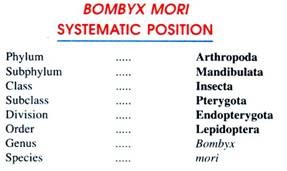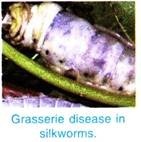ADVERTISEMENTS:
In this article we will discuss about Mulberry Silkworm:- 1. History of Mulberry Silkworm 2. Habit and Habitat of Mulberry Silkworm 3. External Features 4. Life Cycle 5. Economic Importance 6. Diseases 7. Other Silkworm Moths.
History of Mulberry Silkworm:
Bombyx mori is popularly called the Chinese silkworm or Mulberry silkworm moth. It is well known for genuine silk. The importance of silkworm in silk production was known in China during 3500 B.C. The Chinese people knew the methods for cultivating silk and of preparing cloth from it for more than 2000 years. The rearing of silk moth and production of raw silk is known as sericulture.
The art of sericulture was held by Chinese a very close secret, so much so, that the leakage of any information or attempt to export eggs or living cocoons was punishable with death. Even then silk was after all introduced in Europe by two monks, who were sent to China as spies.
ADVERTISEMENTS:
They studied the nature, source and art of silkworm rearing and stealthily carried some eggs in their pilgrim’s staff to Constantinople in 555 A.D.
From this place the silkworm-rearing was spread into the Mediterranean and Asiatic countries including India, Burma, Thailand and Japan. The insect breeders have produced many races of silkworm moth by hybridisation to meet the requirements of climate, rapidity of reproduction, quality, colour and yield of silk.
Habit and Habitat of Mulberry Silkworm:
Bombyx mori or the Mulberry silkworm is completely domesticated organism and is never found wild. The adult moths seldom eat and are primarily concerned with reproduction.
ADVERTISEMENTS:
Their larvae are voracious eaters. They feed on the leaves of mulberry trees. Some moths are single brooded or univoltine and others are many brooded or multivoltine. Owing to domestication, a large number of strains have evolved out, which produce cocoons of various shapes, sizes, weights and colours ranging from white to yellow.
Only one generation is produced in one year by worms in Europe and other countries where the length of winters far exceeds the duration of summers. Some strains pass through two to seven broods and are cultivated in warm climates. In South India, particularly Mysore, Coimbatore and Salem, a strain which produces several generations, extensively utilised to produce silk.
External Features of Mulberry Silkworm:
The adult moth is about 25.00 mm long with a wing-span of 40.00 to 50.00 mm. The female silk moths are larger than the males. The moth is quite robust and creamy-white in colour. The body is distinctly divisible into three regions, namely head, thorax and abdomen.
The head bears a pair of compound eyes, a pair of branched or feathery antennae and the mouth parts. The thorax bears three pairs of legs and two pairs of wings. The cream-coloured wings are about 25.00 mm long and are marked by several faint or brown lines. The entire body is covered by minute scales.
Life Cycle of Mulberry Silkworm:
The silk moth is dioecious, i.e., the sexes are separate. Fertilisation is internal, preceded by copulation. The development includes a complicated metamorphosis.
Eggs:
After fertilisation, each female moth lays about 300 to 400 eggs. These eggs are placed in clusters on the leaves of mulberry tree. The female covers the eggs by a gelatinous secretion which glues them to the surface of the leaves. The eggs are small, oval and usually slightly yellowish in colour. The egg contains a good amount of yolk and is covered by a smooth hard chitinous shell.
After laying the eggs the female moth does not take any food and dies within 4-5 days. In the univoltine (a single brood per year) they may take months because overwintering takes place in this stage but the multivoltine broods come out after 10-12 days. From the egg hatches out a larva called the caterpillar.
Larva:
The larva of silkworm moth is called caterpillar larva. The newly hatched larva is about 4.00 to 6.00 mm in length. It has a rough, wrinkled, hairless and yellowish white or greyish worm-like body. The full grown larva is about 6.00 to 8.00 cm in length. The body of larva is distinguishable into a prominent head, distinctly segmented thorax and an elongated abdomen. The head bears mandibulate mouth and three pairs of ocelli.
ADVERTISEMENTS:
A distinct hook-like structure, the spinneret, is present for the extrusion of silk from the inner silk-gland. The thorax forms a hump and consists of three segments. Each of the three thoracic segments bears pair of jointed true legs. The tip of each leg has a recurved hook for locomotion and ingestion of leaves.
The abdomen consists of ten segments of which first nine are clearly marked, while the tenth one is indistinct. The third, fourth, fifth, sixth and ninth abdominal segments bear ventrally a pair of un-jointed stumpy appendages each.
These are called pro-legs or pseudo-legs. Each leg is retractile and more or less cylindrical. The eighth segment carries a short dorsal anal horn. A series of respiratory spiracles or ostia are present on either lateral side of the abdomen.
ADVERTISEMENTS:
The larva is a voracious eater and strongly gregarious. In the beginning chopped young mulberry leaves are given as food but with the advancement of age entire and matured leaves are provided as food. The caterpillar moves in a characteristic looping manner. The larval life lasts for 2-3 weeks. During this period the larva moults four times.
After each moult, the larva grows rapidly. A full-grown larva is about 8.00 cm long and becomes transparent and golden brown in appearance. A pair of long sac-like silk-glands now develops into the lateral side of the body. These are modified salivary glands.
Pupa:
The full-grown larva now stops feeding and hides itself in a corner under the leaves. It now begins to secrete the clear and sticky fluid of its salivary glands through a narrow pore called the spinneret situated on the hypo pharynx. The sticky substance turns into a fine, long and solid thread or filament of silk into the air.
The thread becomes wrapped around the body of the caterpillar larva forming a complete covering or pupal case called the cocoon. The cocoon-formation takes about 3-4 days. The cocoon serves a comfortable house for the protection of the caterpillar larva for further development.
ADVERTISEMENTS:
The cocoon is a white or yellow, thick, oval capsule which is slightly narrow in the middle.
It is formed of a single long continuous thread. The outer threads, which are initial filaments of the cocoon, are irregular but the inner ones forming later the actual bed of the pupa, is one long continuous thread about 300 metres in length, wound round in concentric rings by constant motion of the head from one side to the other about 65 times per minute.
ADVERTISEMENTS:
The irregular surface threads are secreted first and the inner continuous thread later. The silk thread is secreted at the rate of 150 mm per minute. Within a fortnight the caterpillar larva transforms into a conical brownish creature called the pupa or the chrysalis.
The pupa lies dormant, but undergoes very important active changes which are referred to as metamorphosis. The larval organs such as abdominal pro-legs, anal horn and mouth parts are lost. The adult organs such as antennae, wings and copulatory apparatus develop. The pupa finally metamorphoses into the imago or adult in about 2-3 weeks time.
Imago or Adult:
The adult moth emerges out through an opening at the end of the cocoon in about 2 to 3 weeks time, if allowed to live. Immediately before emergence, the pupa secretes an alkaline fluid, that softens one end of the cocoon and after breaking its silk strands, a feeble crumpled adult squeezes its way out. Soon after emergence, the adult silk moths mate, lay eggs and die.
Economic Importance of Mulberry Silkworm:
The mulberry silkworm moth is a very useful and valuable insect. It provides two very important products such as silk and gut to the mankind.
1. Silk:
The true silk of commerce is the secretion of the caterpillars of silkworm moth. Silk is a secretion in the form of fine threads, produced by caterpillars in preparing cocoons for their pupae. Long sac-like silk- glands, which are, in fact, modified salivary glands, secrete a thick pasty substance, which is passed out through a pair of fine ducts that open on the lower lip.
ADVERTISEMENTS:
This secretion is spun by the caterpillar into fine threads which harden on exposure to air to form fairly strong and pliable silk-strands. The caterpillar larva prepares silk filaments several thousand metre in length at the rate of 15.00 cm per minute.
2. Gut:
Another economic value of the silkworm is the preparation of gut used for surgical and fishing purposes. For preparing the gut, the intestines of silkworms are extracted, made into strings, dried, treated and packed. This industry has good prospects and is growing in Italy, Spain, Formosa, Japan and India.
Diseases in Silkworms:
Silkworms suffer form several diseases. Chief of these is pebrine caused by a protozoan parasite Nosema bombycis of the microsporidian group.
In this disease the caterpillars turn pale brown and later on shrink and die. This disease is highly infectious, transmittable through eggs and responsible for very heavy economic losses. The control is brought about by a microscopic examination of the body fluids of the female, in which the parasites (pebrine corpuscles) are met with.
ADVERTISEMENTS:
The eggs may be discarded or retained according to the presence or absence of parasites. Other diseases are fletcherie and grasserie but of minor importance. Sometimes caterpillars exhibit symptoms like jaundice disease, i.e., losing appetite, showing irregular growths, etc.
Other Silkworm Moths:
There are two other silkworm moths which also yield silk. These are Attacus receni, B, the Eri silkworm moth and Antherea paphia, B, the tassar silkworm moth. Both these moths belong to the family Saturnidae are large-sized and their caterpillars are also considerably monstrous, stout and about 10.00 cm long.
The Eri silkworm which lives upon castor, is a domesticated form, cultivated in warm damp places. It is found in South-East Asia. Its life history resembles that of the mulberry worm. Its cocoon has loose texture and silk is not reliable, hence, this is carded and spun. The gloss on the thread is inferior. Adults are stout dark moths with dark brown white spotted and striped wings.
The tassar silkworm resembles the Eri but the caterpillars feed upon Dalbergia, Shorea, and Terminalia, etc. The cocoon is hard shell-like of the size of a hen’s egg and is generally found attached to a plant by a stalk.
The moth has yellowish or deep brown wings with an eye-spot on each one. It is found in China, India and Sri Lanka. Cocoon has reelable silk. This is a wild variety but can be domesticated. The silk produced by Eri silkworm and tassar silkworm is not of very good quality.
Other silkworms, viz., Moon moth, Atlas moth, Cashew caterpillars and Ficus worm, although produce silk cocoons but the quality of filament produced is inferior and weak, hence, they have no economic value.









